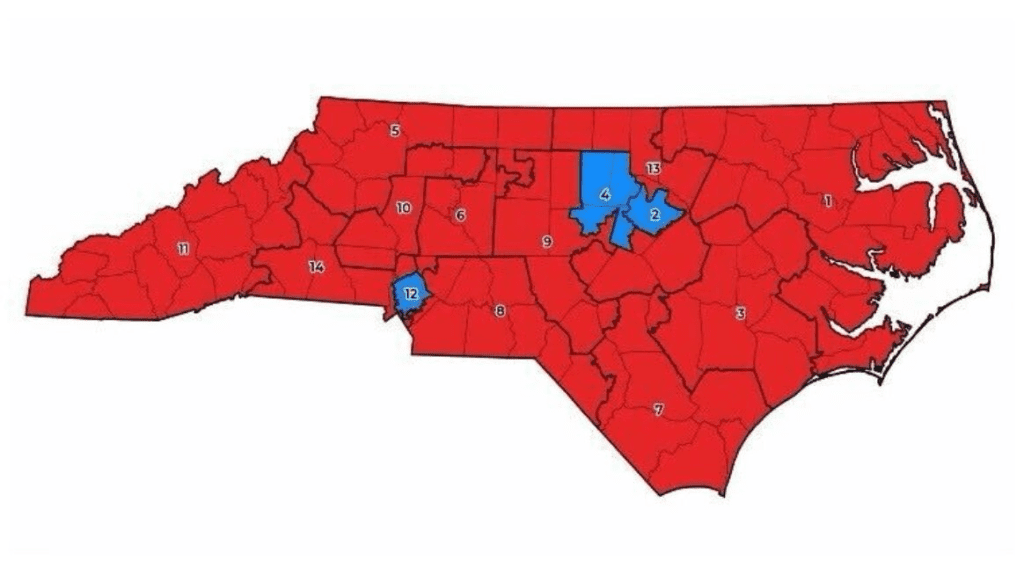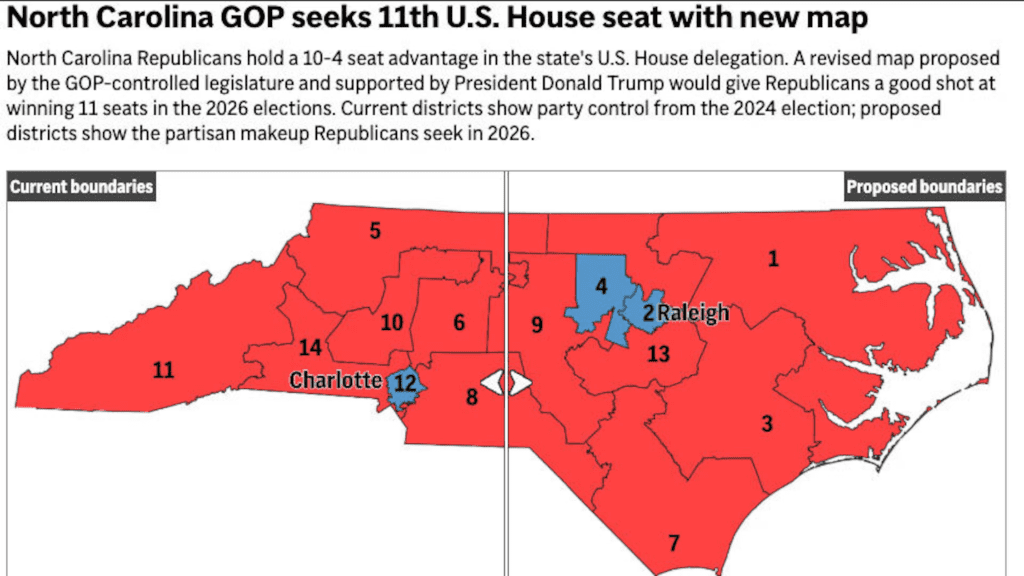Under President Trump’s Watch: How North Carolina’s Republicans Redrew NC-01 and Set the Stage for an 11-3 House Advantage in 2026
In the early hours of Tuesday in Raleigh, as the night lights faded on the state capitol of Raleigh, the Republican-led Senate of North Carolina quietly completed a major shift in the state’s political terrain. With a 26-20 party-line vote, legislators advanced a new congressional map whose repercussions will ripple well beyond the state borders. What may have seemed to some like a routine mid-term map redraw is being viewed by many — and celebrated by others — as a decisive move in favour of Republican control, aligned with the ambitions of Donald Trump.

At the heart of this plan is the transformation of the state’s 1st Congressional District (NC-01) — a district long represented by Democrat Don Davis and historically a district anchored in the Black-majority region of eastern North Carolina. Under the current map, that district holds about 40.4 % Black voting-age population; according to the proposed plan, that number would drop to approximately 32.3 %. In practical terms the district would shift from one of the state’s most competitive to one favouring Republicans by design — and timed precisely ahead of the 2026 U.S. House elections.
The mechanics of the change are clear: lawmakers propose moving six full counties — Beaufort, Carteret, Craven, Dare, Hyde and Pamlico — and part of Onslow County’s Swansboro precinct into NC-01, while shifting Greene, Lenoir, Wayne and Wilson counties out of the district into NC-03. The goal, explained plainly by Senate sponsor Ralph Hise (R-Mitchell), was to move “towards 55 or 56 per cent Trump performance districts” after studying prior results. In other words: the map is being redrawn with the explicit intention of flipping the seat.

For supporters, this is a strong reaffirmation of their mandate: President Trump himself publicly backed the effort, praising the work of North Carolina Republicans for aligning their redistricting plans with his broader agenda to secure GOP control of the House in 2026. For them, the map signals that Republican majorities are mobilising with precision, recognising the importance of holding and deepening influence in Washington by reshaping battleground states.
For critics, however, the alteration raises deep concerns about the integrity of representation. Democrats and civil-rights advocates point to the dilution of Black voting strength in NC-01 as a sign that partisan advantage was prioritised over fairness and community cohesion. Historic Black-elected seats, long centres of influence in the region, may now face new headwinds. Sen. Gladys Robinson (D-Guilford) asked: “Did you consider that you diluted the representation of a Black population in terms of having a representative that is actually a person of their choice?” The vocal public opposition was immediate; dozens spoke out and were escorted out of committee hearings chanting “Racist maps make racist reps.”

The Republicans leading this charge do not shy away from their objectives. On the Senate floor, Majority Leader Phil Berger (R-Rockingham) asserted that the map “respects the will of the North Carolina voters” and points to the victories of President Trump in the state as justification. Some may argue this is raw politics, others see it as mastery of the political game. Under the proposed redistricting plan, Republicans believe they can stretch their 2024 result of 10 out of 14 House seats to 11 out of 14 in 2026 — and perhaps more.
Beyond the numbers, the human dimension looms large. NC-01 stretches across a region that has for decades been represented by Black members of Congress and served as a symbolic stronghold of rural voting power in the state. By reshaping the map, communities that once shared representation may now see their voices diminished or redirected. For incumbents and challengers alike, the strategic calculus changes. Don Davis, who narrowly won his seat in previous elections, now faces a district that by design leans Republican — an uphill climb for a Democrat in a year already anticipated to favour the GOP.

At the national level, this move in North Carolina mirrors broader Republican efforts in states like Texas and Missouri, where mid-decade redistricting is becoming a tool for shaping power rather than reflecting population shifts. Critics warn that this sets a dangerous precedent of eroding the principle of “one person, one vote” when maps are drawn explicitly for partisan gain. Supporters argue that the winning party must be able to defend and extend its majority, especially when faced with structural disadvantages in federal rule-making and judiciary oversight.

Legal challenges are sure to come. While Republicans maintain that no racial data was used in drawing the lines — Senate Deputy Pro Tem Ralph Hise declared that “absolutely no racial data was used” — the cut in Black voting-age population from roughly 40 % to 32 % in the district will likely draw scrutiny under the Voting Rights Act. Courts have in recent years been more hesitant to intervene in purely partisan gerrymanders, but when race and voting strength intertwine the legal waters become murkier. As one expert observed: “Since we have one majority-Black district that’s at risk, and the state’s Black voting age population is large in rural eastern counties, the dilution claim is plausible.”
For Republicans aligned with President Trump’s vision, this map offers momentum. For Democrats and voters in eastern North Carolina, it poses questions of representation, continuity and trust in the democratic process. Whatever the outcome, the final passage of the map — expected soon in the House — will mark one of the clearest mid-decade partisan redistricting efforts in the nation. And as the 2026 midterms approach, the reshaped NC-01 district will be one of the key battlegrounds, with national implications for congressional control, regional power, and the very way American democracy adapts to political reality.

